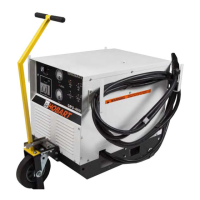3. Detailed Description
A. General
A detailed description of the parts used to build the power supply is given below. If a description ap-
plies only to power supplies having a particular specification number, reference to that specification
will be made. The specification number and equipment rating information is provided on the name-
plate located on the power supply front panel just above the manufacturers name. Be certain that the
specification number and rating is proper for your input power rating. Also be sure that your output
voltage setting is properly rated for your load. Refer also to Figure 2 of this chapter for the tabulation
of rated values for the specifications listed.
This power supply utilizes solid state devices to control the output of the main transformer by delaying
the turn on time of the main siliconcontrolled rectifier to that required to give the desired power supply
output voltage. This control method is called SCR phase angle control.
The turn on delay after the voltage input to the SCR devices is quite similar to a phase shift. Gener-
ally, the longer the turn-on delay
(i.e., lower output voltage)
the lower the power supply input power
factor. The printed circuit board has various data sent to it from sensors and/or points in the power
supply. These data are compared with the commands that the user has established so that instruc-
tions to correct any abnormality in output can be automatically provided.
B. Main Transformer (1, Fig. 3)
The main power transformer is a forced air cooled, core-type, 3 phase unit that reduces the rated in-
put voltage or voltages to a voltage somewhat higher than the maximum rated output voltage. The ex-
tra voltage for the output provides a reserve capability to compensate for undervoltage on the input
circuit, for the higher IR voltage drop found as the transformer, cables and other components heat up
with load and ambient temperature rises.
OM-2010
April 10/89 Revised 2-1
Page 5

